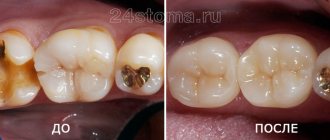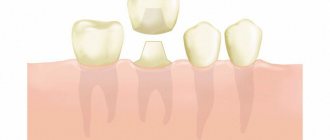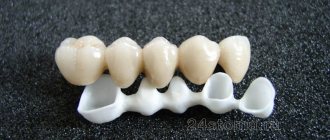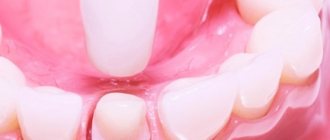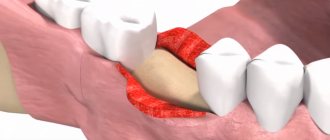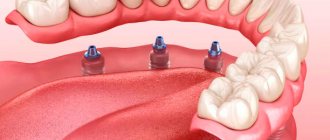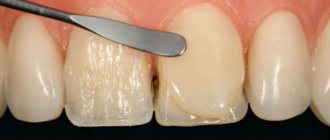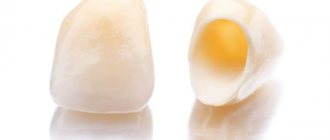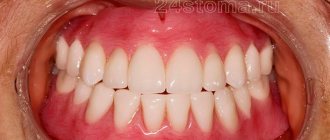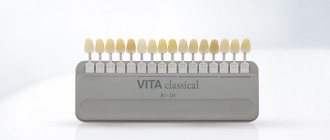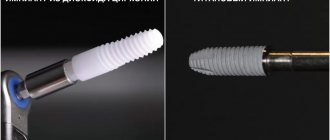- Metal-free ceramics
- Manufacturing technology and installation of ceramic crowns
- Care and service life of ceramic crowns
- Metal-ceramic crowns on teeth
- Manufacturing technology and installation of metal ceramics
- Care and service life of metal ceramics
- What to choose?
In modern dental prosthetics, metal-ceramics and ceramics are among the most popular materials. However, they can hardly be considered interchangeable options - in each specific case the appropriate material is determined individually, because metal-free ceramics and metal ceramics have significant functional and structural differences.
Main types of metal ceramics
Metal-ceramic dentures consist of a metal base, onto which a ceramic coating is applied layer by layer and fired. Metal-plastic crowns are made in a similar way (the metal base is covered with plastic), but the plastic coating is very fragile and short-lived. Therefore, when the question arises: which teeth are better than metal-ceramics or metal-plastic, metal-ceramic structures always win. Technology using ceramics has made it possible to obtain high strength and achieve good aesthetics of dentures. Depending on the composition of the frame, such crowns are divided into two main types:
- Metal ceramics based on base metal alloys. In this case, cobalt-chromium or nickel-chromium alloys are used. They are inexpensive, but have a dark shade and can change the color of the prosthesis, shining through the ceramic layer of the coating if it is not thick enough, making it noticeable against the background of natural teeth.
- Metal ceramics based on precious metals, the most popular of which is gold. It does not distort the color of the crown; due to its yellowness, it gives the ceramic a warm tint and provides a higher aesthetic result. This is a better metal-ceramic compared to the previous option. However, such prostheses will be somewhat more expensive than them.
Thus, patients who have chosen metal-ceramic crowns can choose the best option for themselves in terms of price/quality ratio.
What problems may arise after prosthetics?
Possible problems after metal-ceramic prosthetics include the possibility of darkening of the gum edge. This may appear immediately after the crowns are installed or several weeks later.
The cause of the defect is associated with a metal frame protruding through the mucous membrane. The visibility of such a flaw directly depends on the person’s smile. If your gums are visible when you smile, then the darkening of the gum edge will be noticeable to others.
If the installation was carried out by an unqualified dentist or low-quality materials were used during manufacturing, there is a possibility that chips and cracks will appear on the structure after a few weeks. Other possible problems include:
- galvanic syndrome (metallic taste);
- the appearance of inflammation of the gum tissue under the structure (due to improper oral care and penetration of food debris and pathogens under the crown);
- pain and discomfort (feelings of the presence of a foreign body). This problem can arise if the anatomical features of the oral cavity were not taken into account when making crowns. For example, if the structure is too high, the tooth begins to experience increased loads;
- development of carious lesions (the probability is high if the crown is not closely adjacent to the gum);
- increased sensitivity. If the molar or premolar located under the crown has not been pulped, then there is a high risk of increased sensitivity to heat and cold.
One of the disadvantages of metal ceramics is the blueness of the gums.
Main types of metal-free structures
Metal-free crowns do not have a metal frame and can be made from the following materials:
- Porcelain. Porcelain crowns are made by firing and subsequent glazing. This method allows you to obtain a fairly durable and at the same time aesthetic denture.
- Zirconium dioxide. The most popular material today. Like cermets, zirconia serves as a framework onto which the ceramics are applied. Only the latter material has a natural white color and does not change the shade of the artificial tooth, unlike dark metal.
It is worth noting that metal-free prostheses are manufactured using modern CAM/CAD technology. This technique is considered the most advanced today and allows you to achieve outstanding accuracy of the finished crown. After the doctor takes impressions of the jaws, they are transferred to a computer, which cuts out the frame from a zirconium dioxide blank with maximum precision. A crown made in this way does not require further adjustment and grinding after installation.
In general, metal-free crowns can be considered the most modern, aesthetic and expensive.
Manufacturing technology and installation of ceramic crowns
Ceramic crowns are manufactured in advanced dental laboratories using modern equipment. After preparing the tooth, impressions are taken of it, which are analyzed by a computer program, and the resulting data is transferred to a high-tech milling machine.
Basic approaches to the manufacture of prostheses:
- Press ceramics, or pressed casting method - in this case, porcelain is applied in layers.
- Computer modeling of all-ceramic prostheses (CAD/CAM technologies).
Metal ceramics or metal-free ceramics, which is better: main advantages
In order to figure out what is better for teeth, ceramics or metal-ceramics, it is necessary to compare the pros and cons of both materials.
As noted earlier, metal-ceramic prostheses are characterized by good strength, good aesthetics and reasonable cost. In addition, they have a long service life, and if it is necessary to restore chips, it is not necessary to remove the crown. Repairs can be carried out directly in the mouth, which is very convenient and practical.
Metal-free crowns have better aesthetics, and in terms of strength they are only slightly inferior to metal-ceramics. Consequently, they can be considered universal and recommended for installation not only on the front teeth or canines, but also on the chewing teeth. They are also thinner, so less tooth grinding is required to install them. Do not cause allergies. If all operating rules are followed, the service life of metal-free crowns is about 15 years.
Care and service life
If we are talking about solid-cast ceramics (and not ceramics with a frame made of zirconium dioxide or aluminum oxide), its strength is still inferior to a metal-ceramic product. The service life is determined to be 5-8 years, subject to proper care and compliance with doctor’s recommendations.
It is important to brush your teeth regularly, avoid using floss (or use it very carefully) to avoid “removing” the crown, and do not forget about the need for professional cleaning every 3-4 months.
Let's compare the disadvantages
The materials discussed in the article have not only advantages, but also disadvantages.
Disadvantages of metal-ceramic crowns
- It is necessary to grind down more of your own tooth tissue due to the large thickness of the walls of the prosthesis.
- Almost always, tooth depulpation is required.
- An allergy to metal (except precious metals) may develop.
- If manufacturing technology is violated, artificial teeth may have a darker color.
Disadvantages of metal-free crowns
- High price.
- Complex manufacturing process.
- Slightly inferior in strength to metal.
Based on the totality of these characteristics, it can be noted that zirconium or metal-free crowns are better than metal-ceramics and can be recommended to those patients who want to get the most beautiful smile.
Pros and cons of metal ceramics
Advantages:
- They are visually pleasing, can be matched to the color of your teeth, and have the same visual properties as natural teeth.
- Durability. They are extremely durable dental materials that easily withstand the stress of chewing and years of wear and tear. Thus, they can last for several years.
- Minimal grinding.
Flaws:
- Some patients have individual intolerance to metals.
- The ceramic part sometimes peels off from the metal structure.
Are you interested in a metal-ceramic crown? The price is clarified in the corresponding section of our website, by phone or directly at the dentist’s appointment.
Zirconium - an alternative to metal ceramics?
Above we compared all the advantages, disadvantages and features of both materials. Based on the information presented, we can conclude that zirconium and metal-ceramic crowns are worthy options for prosthetics, but they are designed for different groups of patients. Metal-ceramics can be used for those patients who value reliability, reasonable cost and do not need ideal aesthetics. Zirconium crowns are chosen by those patients who are most concerned about the aesthetic issue and other characteristics are not so important.
Possible complications after surgery
If the work of an orthopedic dentist or dental technician is of poor quality, the following may occur:
- Inflammation under the crown. If the canals have not been thoroughly sanitized and completely obturated, a purulent process (granuloma, cyst, etc.) will develop at the root apex. In this case, you will have to remove the prosthesis, treat and replace the tooth.
- Crown loss. It occurs if the prosthesis is not made accurately, as a result of which it does not fit tightly to the stump and a gap forms between the frame and the neck of the teeth. Liquids fall into it, which wash out the adhesive and lead to de-cementing.
- Secondary caries under the crown and gum hyperemia. They also develop due to a loose fit of the structure to the stump. Bacteria accumulate around the neck of the tooth, which leads to inflammatory processes.
- Inconsistency with the bite. If mistakes were made when taking impressions and making the structure, it will interfere with the closure of the jaws. Therefore, it is advisable to walk for 2-3 days with an unfixed prosthesis before attaching it with permanent cement.
- Stump fracture. It occurs if, when restoring or preparing a tooth crown, mistakes were made - a pin was used where a stump inlay was needed, or too much tissue was ground off.
- Ceramic chips. Typical for dentures with cheap porcelain lining. This problem also occurs with crowns and bridges that were fired incorrectly: at an excessively low or high temperature, the kiln was opened too early or late, etc.
This is what chips look like on metal ceramics.
Another problem that inevitably arises with any prosthetics is supercontacts. At the time of fixation of the prosthesis, it fully corresponds to the occlusion. But the teeth are a little mobile, they gradually shift over time. Plus, ceramics are stronger than their own fabrics and do not wear off, unlike enamel.
On average, dental clinics provide a guarantee for metal-ceramic dentures from 1 to 3 years. The obligation stipulates that if the crowns are broken or destroyed, they will be repaired or replaced free of charge.
However, this does not always protect the patient from unnecessary waste. Most often, teeth have to be re-treated due to the development of secondary caries or inflammation at the root tips. The first occurs when the structure is poorly made, the second occurs when the canals are poorly obturated.
But it is unrealistic to prove that caries or inflammation appeared due to the fault of the attending physician. Therefore, even at the stage of prosthetics, ask you to write down or print out all the photographs of the teeth, and carefully ask about the quality of materials for the manufacture of the frame and veneer.
Clinics provide a guarantee of 1 to 3 years on metal-ceramic prostheses
Dentistry Zuub: prosthetics in Moscow
The answer to the question which crown is better: ceramics or metal-ceramics is purely individual. In order to choose the most suitable type of material, you need to consult with a specialist. At the same time, we should not forget that the quality of work is also of great importance, which largely determines the result of the entire treatment. Trust your dental prosthetics to professionals - sign up for a consultation at the Zuub Clinic (Moscow) by calling
If you have the symptoms described in this article, be sure to make an appointment at our clinic.
Don't self-medicate! Even the smallest problem, if not treated correctly, can significantly complicate your life.
By contacting us, you can be sure that:
- Get high-quality and free consultation .
- You will receive the best prices for treatment and the opportunity to receive a special promotional price.
- Only modern equipment and materials will be used.
- You will be treated by professional doctors with many years of experience.
- We offer treatment on credit or in installments. There is also the possibility of obtaining a tax deduction.
- We work seven days a week and without a lunch break, from 9 a.m. to 10 p.m.
+7 (495) 132-02-96
Make an appointment
Comparison
The main difference between metal-ceramics and ceramics can be observed, in fact, already at the level of the names of these materials. The first contains metal - as a material for making the base of the crown. Moreover, its outer part is made of ceramic material. Which, in turn, is used as the main one in crowns of the second type.
Metal ceramics and ceramics differ, except for the composition:
- in many cases by appearance;
- by strength;
- by allergenicity;
- according to the types of teeth on which they are most often placed;
- by price.
To more clearly reflect the difference between metal-ceramics and ceramics in the noted aspects, a small table will help us.
How to install
Preparation
First you need to consult an orthopedic dentist. He will examine the oral cavity and give recommendations on the choice of type of prosthetics, including based on radiography.
Also at the preparatory stage you should:
- Treat caries;
- Remove non-viable teeth;
- Choose the appropriate type of dental crown depending on your preferences and cost.
Sometimes it is necessary to depulp a tooth under a crown, but in some cases this is not done (when there is no need to sharply grind the tooth).
Installation
Quite often, the installation of crowns is necessary for severely damaged teeth. In this case, the canals are first filled and the nerve is removed. Then the doctor restores the crown of the tooth. This is done in two ways:
- Using a pin (titanium rod), which is screwed into the filling;
- Using a stump inlay, the lower part of which is fixed in the root canal, and the upper part is ground for a crown.
At the next stage, the doctor prepares (grinds) the teeth. If the nerve is removed, no anesthesia is required, otherwise an injection is given into the gum. The tooth is given a certain shape with diamond burs, removing from 1.5 to 2.5 mm of hard tissue.
Finally, the doctor takes an impression of the tooth. Using it, a plaster model is made in the laboratory, and with the help of it a crown is made from the required material.
While permanent crowns are being made, temporary plastic crowns are placed on the ground teeth. They not only allow the patient to smile, but also protect the teeth from harmful influences.
Next, the first fitting is done and if there are no problems, the crown is installed with temporary cement. This is necessary in order to determine how the new tooth will behave under load. Installation on permanent cement is carried out after 3-4 weeks, if there are no complaints.
Complications
In some cases, consequences may arise that require immediate removal of the crown.
If tooth preparation is performed poorly, inflammatory processes can occur in the root and canals.
If pain appears under the crown, this means that voids have formed in the gums in which bacteria accumulate.
If the crown does not tightly cover the neck of the tooth, it causes physical and aesthetic inconvenience. This may occur if the doctor neglected the fitting stage or the trial period.
The appearance of cracks and chips before the end of its service life also requires unscheduled replacement of the crown.
